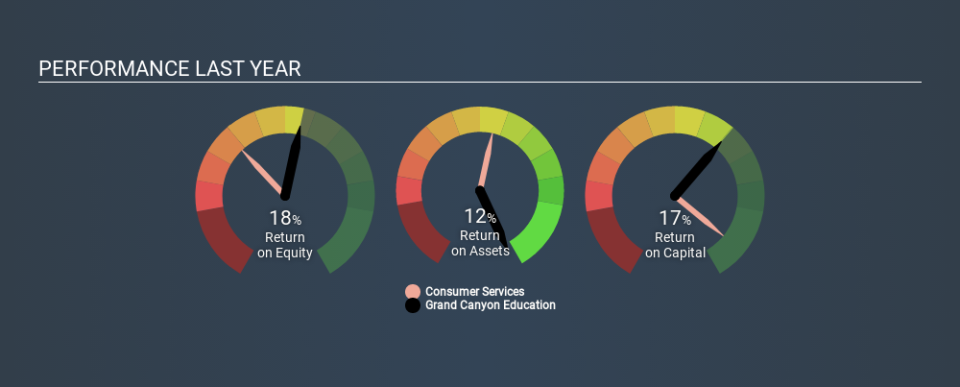Here's What Grand Canyon Education, Inc.'s (NASDAQ:LOPE) ROCE Can Tell Us

Today we'll evaluate Grand Canyon Education, Inc. (NASDAQ:LOPE) to determine whether it could have potential as an investment idea. Specifically, we'll consider its Return On Capital Employed (ROCE), since that will give us an insight into how efficiently the business can generate profits from the capital it requires.
First, we'll go over how we calculate ROCE. Second, we'll look at its ROCE compared to similar companies. And finally, we'll look at how its current liabilities are impacting its ROCE.
Return On Capital Employed (ROCE): What is it?
ROCE measures the amount of pre-tax profits a company can generate from the capital employed in its business. All else being equal, a better business will have a higher ROCE. Ultimately, it is a useful but imperfect metric. Renowned investment researcher Michael Mauboussin has suggested that a high ROCE can indicate that 'one dollar invested in the company generates value of more than one dollar'.
So, How Do We Calculate ROCE?
Analysts use this formula to calculate return on capital employed:
Return on Capital Employed = Earnings Before Interest and Tax (EBIT) ÷ (Total Assets - Current Liabilities)
Or for Grand Canyon Education:
0.17 = US$269m ÷ (US$1.7b - US$95m) (Based on the trailing twelve months to December 2019.)
So, Grand Canyon Education has an ROCE of 17%.
See our latest analysis for Grand Canyon Education
Is Grand Canyon Education's ROCE Good?
ROCE is commonly used for comparing the performance of similar businesses. Grand Canyon Education's ROCE appears to be substantially greater than the 8.1% average in the Consumer Services industry. I think that's good to see, since it implies the company is better than other companies at making the most of its capital. Regardless of where Grand Canyon Education sits next to its industry, its ROCE in absolute terms appears satisfactory, and this company could be worth a closer look.
Grand Canyon Education's current ROCE of 17% is lower than 3 years ago, when the company reported a 28% ROCE. This makes us wonder if the business is facing new challenges. You can see in the image below how Grand Canyon Education's ROCE compares to its industry. Click to see more on past growth.
It is important to remember that ROCE shows past performance, and is not necessarily predictive. ROCE can be misleading for companies in cyclical industries, with returns looking impressive during the boom times, but very weak during the busts. This is because ROCE only looks at one year, instead of considering returns across a whole cycle. What happens in the future is pretty important for investors, so we have prepared a free report on analyst forecasts for Grand Canyon Education.
Do Grand Canyon Education's Current Liabilities Skew Its ROCE?
Liabilities, such as supplier bills and bank overdrafts, are referred to as current liabilities if they need to be paid within 12 months. The ROCE equation subtracts current liabilities from capital employed, so a company with a lot of current liabilities appears to have less capital employed, and a higher ROCE than otherwise. To counter this, investors can check if a company has high current liabilities relative to total assets.
Grand Canyon Education has current liabilities of US$95m and total assets of US$1.7b. Therefore its current liabilities are equivalent to approximately 5.6% of its total assets. With low current liabilities, Grand Canyon Education's decent ROCE looks that much more respectable.
The Bottom Line On Grand Canyon Education's ROCE
This is good to see, and while better prospects may exist, Grand Canyon Education seems worth researching further. Grand Canyon Education looks strong on this analysis, but there are plenty of other companies that could be a good opportunity . Here is a free list of companies growing earnings rapidly.
If you like to buy stocks alongside management, then you might just love this free list of companies. (Hint: insiders have been buying them).
If you spot an error that warrants correction, please contact the editor at editorial-team@simplywallst.com. This article by Simply Wall St is general in nature. It does not constitute a recommendation to buy or sell any stock, and does not take account of your objectives, or your financial situation. Simply Wall St has no position in the stocks mentioned.
We aim to bring you long-term focused research analysis driven by fundamental data. Note that our analysis may not factor in the latest price-sensitive company announcements or qualitative material. Thank you for reading.

 Yahoo Finance
Yahoo Finance 